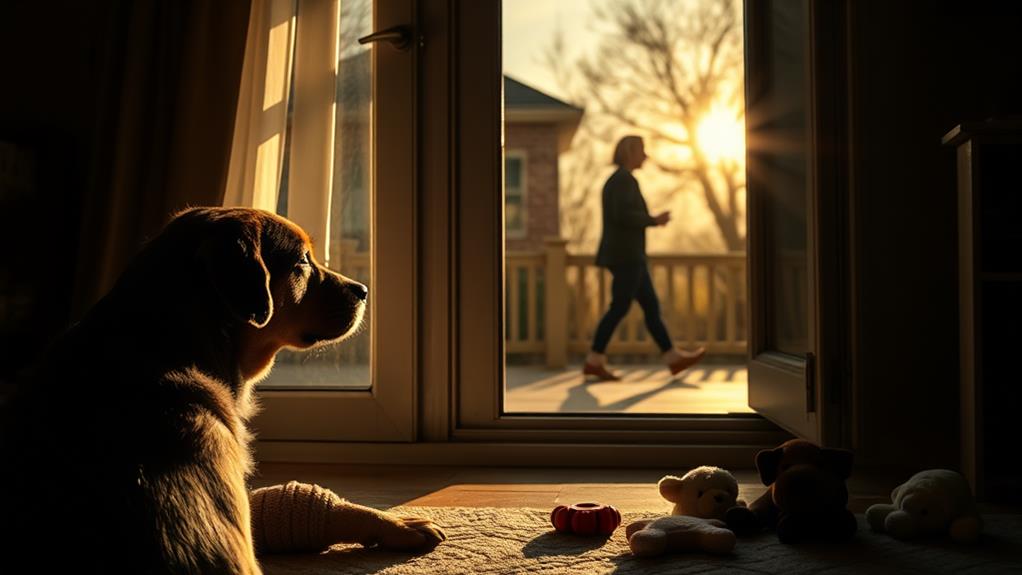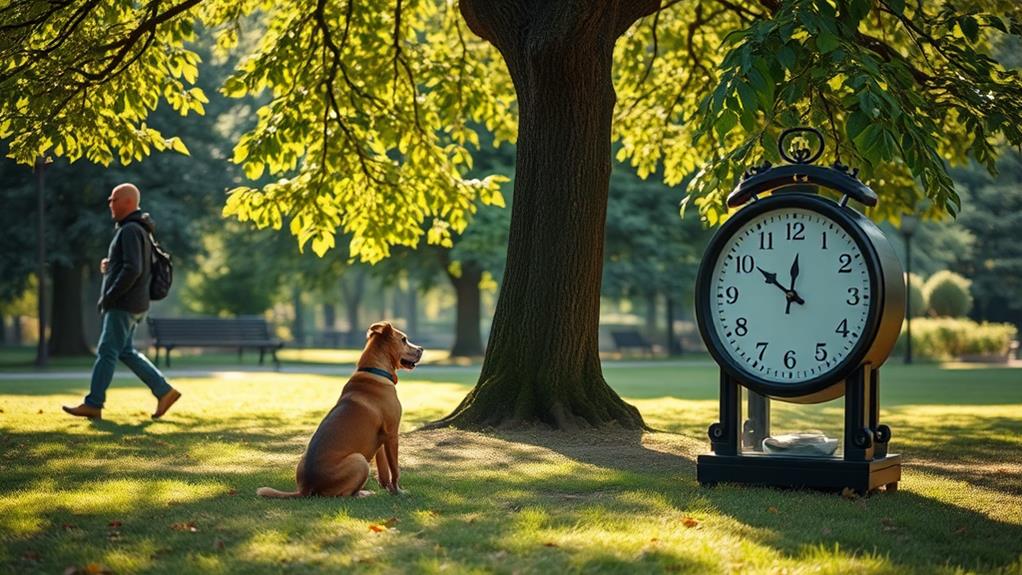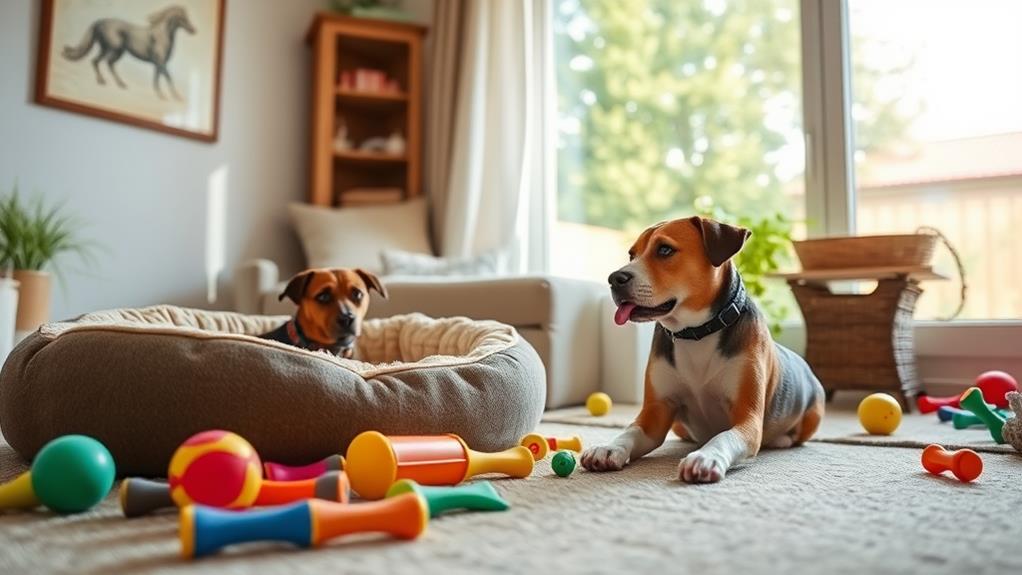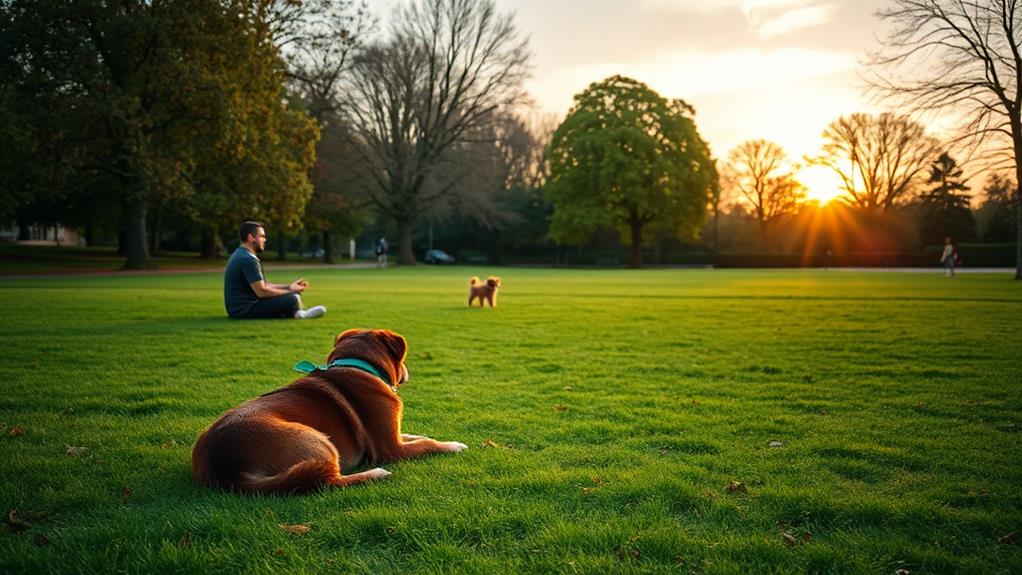To curb your dog's separation anxiety, start by understanding the causes behind their distress. Often, past experiences or changes in routine can trigger these feelings. Next, use gradual desensitization techniques: leave your dog in a comfortable space for a few minutes, then slowly increase the time apart while rewarding calm behavior. Finally, provide comforting distractions like interactive toys or soothing music to keep their mind engaged. These strategies foster security and help your dog feel less anxious when you're away. By following these essential tips, you can create a more relaxed environment for both you and your furry friend. There's more to explore on this topic!
Understand the Causes

To tackle separation anxiety in dogs, it's crucial to understand the underlying causes. Often, this anxiety stems from a dog's past experiences. If your dog was abandoned, rehomed, or frequently left alone during critical developmental stages, they may struggle with separation. Recognizing these factors is the first step toward helping your furry friend.
Another common cause is a lack of socialization. If your dog hasn't been exposed to different environments, people, or other animals, they might feel insecure when left alone. This insecurity can manifest as anxiety whenever you step out the door. Additionally, changes in your routine, such as moving to a new home or welcoming a new family member, can trigger anxiety. Dogs thrive on stability, and any disruption can lead to distress.
Lastly, some breeds are predisposed to separation anxiety due to their strong attachment to humans. If you have a breed known for its loyalty, they may need extra attention and reassurance. By understanding these causes, you can better empathize with your dog's feelings and begin to address their anxiety effectively.
Gradual Desensitization Techniques

Gradual desensitization techniques can markedly help reduce your dog's separation anxiety. This method involves slowly getting your dog used to being alone, which can make a significant difference over time. Start by leaving your dog in a safe, comfortable space while you step outside for just a few minutes. Keep it short at first, then gradually increase the duration as your dog becomes more comfortable with your absence.
Pay attention to your dog's behavior during these short separations. If your dog remains calm, you've hit the appropriate duration. If not, shorten the time and try again. It's crucial to remain calm and not make a big deal out of your departures or arrivals, as this can increase your dog's anxiety.
Incorporate these sessions into your daily routine, so your dog learns that you'll always come back. Use positive reinforcement when your dog behaves well during these separations—treats and praise go a long way! Remember, patience is key; it may take time for your dog to adjust. By gradually desensitizing your furry friend, you can foster a sense of security and reduce their anxiety effectively.
Provide Comforting Distractions

How can you keep your dog engaged and relaxed when you're not home? Providing comforting distractions is key to easing their anxiety. Here are some effective options to ponder:
| Distraction Type | Description | Benefits |
|---|---|---|
| Interactive Toys | Toys that dispense treats or puzzles to solve | Keeps your dog mentally stimulated |
| Calming Music/TV | Play soothing music or leave the TV on | Creates a comforting atmosphere |
| Scented Items | Use a blanket or shirt that smells like you | Offers a sense of security |
Try rotating these distractions to keep things fresh for your dog. Interactive toys can challenge their minds, while calming music can soothe their nerves. Additionally, having a familiar scent nearby can give them comfort during your absence.
Don't forget to start with short periods away and gradually increase the time to help your dog adjust. With these comforting distractions, you'll help reduce their anxiety and make your time apart more manageable for both of you.
Frequently Asked Questions
Can Separation Anxiety Be Diagnosed by a Veterinarian?
Yes, a veterinarian can diagnose separation anxiety in dogs. They'll evaluate your dog's behavior, discuss symptoms, and may suggest tests to rule out other issues. It's important to address your concerns during the visit.
Are Certain Dog Breeds More Prone to Separation Anxiety?
Imagine a delicate flower needing constant sunlight; some dog breeds, like Border Collies or Labradors, thrive on companionship. They're more prone to separation anxiety, so understanding their needs helps you nurture their well-being effectively.
How Long Can a Dog Be Left Alone Safely?
You can usually leave your dog alone for about four to six hours, depending on their age and temperament. Puppies and older dogs may need shorter durations to feel comfortable and secure while you're gone.
What Are the Signs of Severe Separation Anxiety?
You'll notice severe separation anxiety in your dog through excessive barking, destructive behavior, trembling, or attempts to escape. They might also try to follow you everywhere or show signs of distress when you prepare to leave.
Can Medications Help With My Dog's Separation Anxiety?
Yes, medications can help your dog's separation anxiety. They often work alongside behavioral training, easing symptoms and making it easier for your furry friend to cope when you're away. Consult your vet for personalized recommendations.
Conclusion
In summary, tackling separation anxiety in dogs requires patience and understanding. Did you know that nearly 20% of dogs suffer from some form of separation anxiety? By grasping the causes, using gradual desensitization techniques, and providing comforting distractions, you can help your furry friend feel more secure when you're away. Remember, every dog is unique, so be attentive to their needs and celebrate the small victories along the way. Your efforts will make a world of difference!



